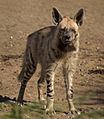Indus Valley Desert facts for kids
The Indus Valley Desert is a dry, sandy area in northern Pakistan. It is a special kind of natural region called an ecoregion. This desert covers about 19,500 square kilometers (7,500 square miles). It lies in the northwestern part of Punjab Province. The desert is found between two important rivers, the Chenab River and the Indus River. The Indus Valley Desert is much drier than the thorny forests around it. This makes it a tough place for plants and animals to live.
Contents
About the Indus Valley Desert
The Indus Valley Desert is known for its very dry climate. It gets very little rain each year. This makes it a challenging place for life. The desert is part of a larger area called the Indomalayan realm. This realm includes many different types of habitats across South and Southeast Asia.
Where is the Indus Valley Desert?
This desert is located in the northern part of Pakistan. Specifically, it is in the northwestern area of Punjab Province. It sits like a long, narrow strip between two major rivers. These rivers are the Chenab River and the Indus River. The rivers help define its borders. They also bring some moisture to the edges of the desert.
What is an Ecoregion?
An ecoregion is a large area of land or water. It has its own unique set of natural communities. These communities include specific plants and animals. They live together in a particular environment. The Indus Valley Desert is an ecoregion because it has distinct features. These features include its dry climate and the types of life found there.
Plants and Animals of the Desert
Even though the Indus Valley Desert is very dry, some amazing plants and animals call it home. They have special ways to survive in this harsh environment. Many of these species are adapted to living with little water.
Desert Plants
The plants in the Indus Valley Desert are tough. They can handle the dry conditions. Many are shrubs or small trees. They often have deep roots to find water. Some plants store water in their stems or leaves. Others have small leaves to reduce water loss. These plants form the base of the desert's food web.
Common Shrubs
You might find plants like the Khejri tree (Prosopis cineraria). This tree is well-adapted to deserts. It can grow in very dry soil. Its roots go deep to find underground water. The Khejri provides shade and food for animals. It is an important part of the desert ecosystem.
Desert Animals
Many animals have adapted to live in the Indus Valley Desert. Some are nocturnal, meaning they are active at night. This helps them avoid the hot daytime temperatures. Others can go long periods without drinking water. They get moisture from their food.
Mammals of the Desert
Several interesting mammals live here. You might find the Striped hyena (Hyaena hyaena). These animals are scavengers. They help keep the desert clean by eating leftover food. The Indian wolf (Canis lupus pallipes) also roams these lands. Wolves are predators. They hunt smaller animals for food. Other mammals include various types of rodents and small carnivores.
Birds of the Desert
The desert is also home to many bird species. Some birds migrate through the area. Others live there all year round. Birds like the Red-necked falcon (Falco chicquera) can be seen hunting. They are fast and agile hunters. Many desert birds have adapted to find food and water in tough conditions.
Images for kids
See also
 In Spanish: Desierto del Valle del Indo para niños
In Spanish: Desierto del Valle del Indo para niños





